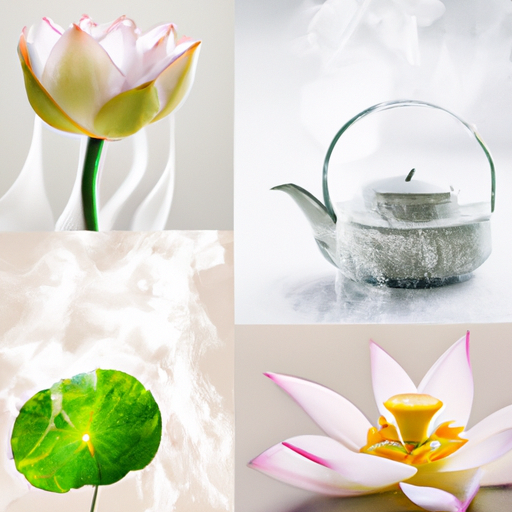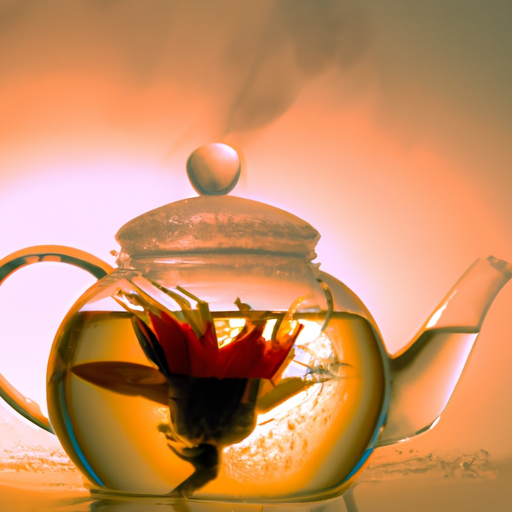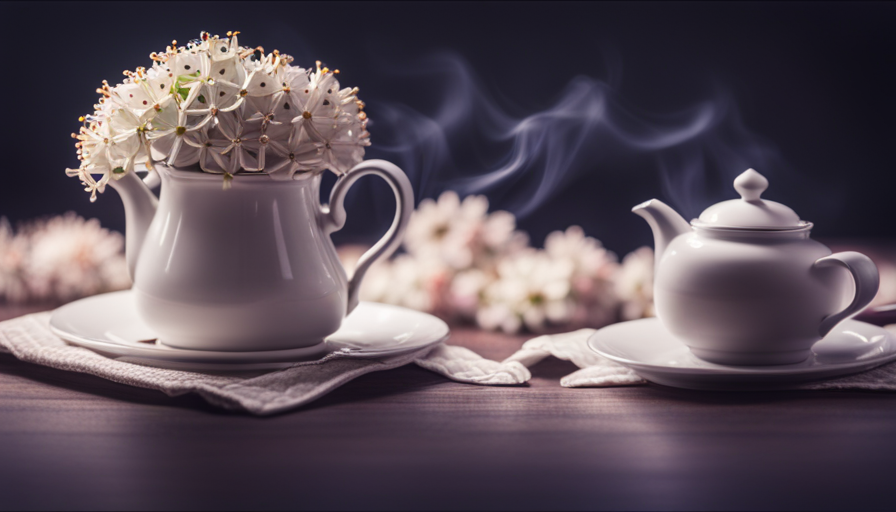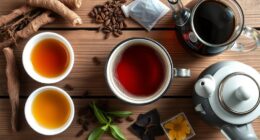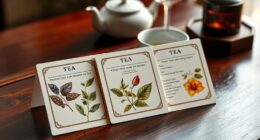Imagine sipping on a cup of tea that not only warms your soul but also delights your senses with its delicate, floral aroma. That’s the magic of tea made with flower petals. It’s like taking a stroll through a vibrant garden, with each sip transporting you to a world of tranquility and beauty.
In this article, I will share with you my expertise on how to make tea with flower petals, guiding you through the process step by step. From choosing the perfect flowers for tea-making to infusing their essence into your brew, I will provide you with all the knowledge you need to create a truly enchanting tea experience.
Whether you’re a tea aficionado looking to expand your repertoire or simply seeking a unique and delightful beverage, join me as we embark on a journey of floral flavors and aromatic bliss.
Key Takeaways
- Choosing pesticide-free flowers is important for making tea with flower petals.
- The petals should be dried before using them in tea.
- Flower petal tea offers health benefits such as boosting the immune system and promoting relaxation.
- Flower petals can be creatively used in cooking and baking, including salads, desserts, syrups, and jams.
Choose the Right Flowers for Tea-making
Make sure you’re using the right flowers for a truly enchanting tea experience! When it comes to making tea with flower petals, it’s important to choose the right flowers and handle them properly.
Start by selecting flowers that are safe for consumption and haven’t been treated with pesticides or other harmful chemicals. Some popular choices include chamomile, rose, lavender, and hibiscus.
Once you have your flowers, gently remove the petals and discard any stems or leaves. To preserve their flavor and aroma, it’s best to dry the petals before using them in your tea. You can do this by spreading them out on a clean, dry surface and letting them air dry for a few days. Once dried, store the petals in an airtight container to maintain their freshness.
Not only do flower petal teas offer a delightful taste, but they also provide numerous health benefits. For instance, chamomile tea is known for its calming properties, while rose tea is rich in antioxidants.
Now that you know how to choose the right flowers and handle them correctly, let’s move on to the next step: harvesting and preparing flower petals for tea.
Harvesting and Preparing Flower Petals
Gather the vibrant, delicate petals of your favorite blossoms, embracing the beauty of nature’s bounty. To ensure the best flavor and quality, it is important to properly harvest and prepare flower petals for tea. Begin by selecting flowers that are pesticide-free and in full bloom. Carefully pluck the petals, avoiding any green parts or stems. Spread them out on a clean surface and allow them to air dry for several days until they become brittle. Once dry, store the petals in an airtight container away from sunlight to preserve their freshness. Flower petal tea not only offers a visually stunning brew, but it also boasts numerous health benefits. Rich in antioxidants, it can aid digestion, promote relaxation, and boost the immune system. Now that the petals are ready, let’s move on to infusing them into a delightful cup of tea.
Infusing Flower Petals into Tea
Once the vibrant flower petals are dry and ready, it’s time to infuse them into your favorite cuppa, creating a visually stunning and health-boosting beverage. Did you know that just one teaspoon of infused flower petals can add a burst of flavor and antioxidants to your tea?
To start, place a teaspoon of dried flower petals into a teapot or tea infuser. Pour hot water over the petals and let them steep for about 5 minutes. As the petals infuse, they release their aromatic oils, filling the air with a delightful fragrance that can be used for aromatherapy.
When the steeping time is up, strain the tea to remove the petals and pour it into your cup. Take a moment to appreciate the vibrant colors and delicate scent before taking your first sip.
Drinking flower petal tea offers numerous health benefits, such as boosting your immune system, reducing inflammation, and promoting relaxation.
Transitioning to enhancing the flavor of flower petal tea, you can experiment with adding a touch of honey or a squeeze of lemon to create a more complex taste profile.
Enhancing the Flavor of Flower Petal Tea
To elevate the taste experience of your floral infusion, why not try adding a dollop of golden honey or a zesty squeeze of fresh lemon? This allows the flavors to dance on your palate like a harmonious symphony. Exploring alternative uses for flower petals in tea not only enhances the flavor but also adds a touch of elegance to your tea time ritual.
The delicate and fragrant petals infuse the tea with their unique essence, creating a sensory experience that’s truly delightful. Moreover, flower petal tea offers a multitude of health benefits, from boosting immunity to promoting relaxation and reducing inflammation. By incorporating these vibrant petals into your tea, you can harness their natural goodness while indulging in a cup of exquisite flavor.
Now, let’s delve into the brewing techniques for flower petal tea, ensuring that each sip is a delightful journey.
Brewing Techniques for Flower Petal Tea
Get ready to embark on a fragrant journey as you steep those vibrant petals, allowing their essence to swirl and mingle in your teacup like a mesmerizing dance. To ensure the perfect brew, start by gently drying the flower petals. Spread them out on a clean towel or parchment paper, away from direct sunlight, and let them air dry for a few days.
This drying process not only preserves the flavor but also enhances the fragrance of the petals. Once the petals are dry, it’s time to brew. Bring water to a boil and pour it over the petals in a teapot or cup. Let them steep for 5-7 minutes, allowing the flavors to infuse. Strain the tea and savor the delicate aroma and taste.
Flower petal tea is not only a delightful beverage, but it also offers various health benefits. The antioxidants present in the petals can boost your immune system and promote overall well-being.
Transitioning into the next section, let’s explore the art of serving and enjoying flower petal tea.
Serving and Enjoying Flower Petal Tea
Indulge in the sensory experience of a fragrant floral infusion, as you gracefully sip on a cup of delicately steeped flower petal tea.
When serving flower petal tea at a tea party, consider incorporating some creative and whimsical ideas. Use delicate teacups with floral patterns, adorn the table with fresh flowers, and offer a selection of sweet treats that complement the tea’s flavors.
Not only does flower petal tea provide a delightful aesthetic, but it also offers several health benefits. The tea is rich in antioxidants, which can help boost the immune system and promote overall well-being. Additionally, different flower varieties lend unique flavors to the tea, allowing for endless possibilities when it comes to exploring different combinations.
So, let’s dive into the world of flower petal tea and unravel the fascinating array of flavors waiting to be discovered.
Exploring Different Flower Varieties and Flavor Combinations
Let’s embark on a delightful journey through the world of flower petal tea, where we can explore the diverse varieties of flowers and their enchanting flavor combinations. Drinking flower petal tea not only offers a delightful sensory experience but also provides numerous benefits for overall health and wellness.
Different flowers such as rose, chamomile, lavender, and hibiscus each contribute their unique properties, from calming effects to boosting immunity. These floral infusions can aid in relaxation, digestion, and even help with insomnia.
Moreover, flower petals can be creatively used in cooking and baking, adding a touch of elegance and flavor to dishes. They can be incorporated into salads, desserts, and even infused into syrups and jams.
So, don’t let those leftover petals go to waste – let your culinary creativity bloom!
Frequently Asked Questions
Can I use any type of flower petals for making tea?
Yes, you can use a variety of flower petals for making tea. Some popular choices include rose petals, chamomile flowers, and lavender. Each type of petal brings unique flavors and health benefits to flower petal tea recipes.
How long do flower petals need to be dried before using them for tea?
To properly dry flower petals for tea, they should be spread out in a single layer and left to air dry for about 1-2 weeks. Flower petals can also be used for potpourri, bath soaks, and homemade beauty products.
Can I use fresh flower petals for making tea?
Yes, fresh flower petals can be used to make tea. They infuse a delicate, floral flavor. Flower petal tea can also be brewed with other types of tea for a unique blend of flavors.
Are there any specific health benefits associated with drinking flower petal tea?
Exploring the potential therapeutic properties of flower petal tea, I’ll discuss the specific health benefits. Incorporating flower petal tea into your daily wellness routine can promote relaxation, boost immunity, and provide antioxidants for overall well-being.
Can flower petal tea be stored for later use, and if so, what is the best way to store it?
Storing flower petal tea is a delicate task. To preserve its enchanting flavors, store it in airtight containers away from light, humidity, and strong odors. This ensures that every sip transports you to a floral paradise.
Conclusion
In conclusion, making tea with flower petals is a delightful and unique experience. By carefully selecting and harvesting the right flowers, you can create a tea infused with delicate and aromatic flavors.
The process of infusing the petals into the tea requires patience and precision, but the end result is a cup of tea that’s both visually stunning and deliciously fragrant.
So, why settle for ordinary tea when you can indulge in the exquisite beauty and taste of flower petal tea?



